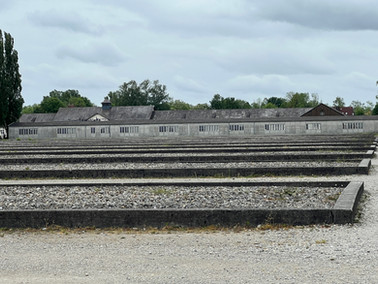MUNICH: DACHAU
- chuckmeltzer
- Jul 17
- 3 min read
Updated: Aug 25
When we decided to tour Germany, my goal was to gain a deeper understanding of modern Germany and to visit a concentration camp firsthand. I wanted to hear from Germans about the post-war rebuilding years and to be assured that such events would never repeat. I left feeling confident that it wouldn't happen again in Germany, though we all recognize how unpredictable our world is and that world peace isn't imminent. Interestingly, it wasn't until the '60s that Germans began to recognize the importance of educating the next generation to be better human beings, taking time to move beyond immediate recovery and reflect on the lessons learned.
We took a train to Dachau, where Stefan provided more context about our visit. He made a chilling remark about the death camps, noting that the leaders wanted to devise a method to make mass murder easier, not for the victims, but for the executioners. It's a horrific concept, but even shooting innocent people, labeled as "subhumans," could affect the soldiers, and it was also a waste of ammunition.
Dachau was established on March 22, 1933, shortly after Adolf Hitler became Reich Chancellor, as a concentration camp for political prisoners. The prisoners included not only Jews but also dissidents, homosexuals, Romani, and others not considered part of the master race. Dachau served as a model for later concentration camps and as a "school of violence" for the SS men in command. Over its twelve-year existence, more than 200,000 people from across Europe were imprisoned here and in its many subcamps. 41,500 were murdered. American troops liberated the survivors on April 29, 1945.
As part of Dachau, there were 140 subcamps established for forced labor. The inmates were forced into slave labor in various industries, from gravel pits to armaments. The number of inmates increased over the years, and many died due to overcrowding, severe malnutrition from lack of food, and typhus outbreaks due to poor hygiene.
Dachau was not originally built as an extermination camp like Auschwitz, though it had a gas chamber that was apparently unused, and a crematorium for disposing of the dead.

During the Nazi regime's "euthanasia actions," SS doctors at Dachau would select sick prisoners who could no longer work and send them on "invalid transports" to a death facility in Austria. The SS doctors also conducted cruel medical experiments on prisoners, testing air pressure changes, cold water exposure, and various malaria antidotes without regard for the prisoners' well-being, as they were deemed "subhumans." SS training indoctrinated soldiers to view prisoners as "subhuman," identified only by ID numbers tattooed on their arms. Many SS troops were uneducated. It's horrifying that educated doctors, trained to heal, could conduct experiments without concern for the pain or death they caused. After the war, many of these doctors were tried at Nuremberg and sentenced to death. One doctor was so unaffected by his crimes that he requested a delay in his execution to summarize his findings — a truly disturbing individual.
Dachau, as a memorial site, distinguishes itself by aiming to educate rather than just shock visitors. A film, which we watched at the start, included footage of what the camp liberators found, and a museum provides background on what happened, why, and how. One of the most striking moments for me was watching the expressions of horror when townspeople were forced to walk through the camps shortly after liberation. It's perplexing how they could not have known what was happening so close to them.
We saw the bunkers where political prisoners were jailed and tortured, the barracks that housed enslaved prisoners, the crematorium, and the gas chamber (which Scotty could not bring himself to enter). These buildings looked just as they do in movies or documentaries. Additionally, there are various memorials set up by Jews, Catholics, and Protestants.
The Nazis clearly aimed for genocide, intending to eliminate all Jews in Europe and others they deemed undesirable. Their extermination industry was so efficient that people arriving in cattle cars at Auschwitz were often in the gas chambers within 10 minutes. While many top leaders faced consequences at the Nuremberg trials, others returned to their homes, families, and jobs, living silently with the consequences of their actions. This likely contributed to the delay until the 1960s to begin proactively educating future generations about their complicity.





























Comments